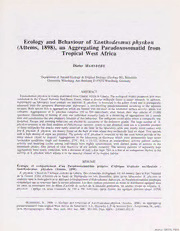
Ecology and behaviour of Xanthodesmus physkon (Attems 1898), an aggregating paradoxosomatid from tropical West Africa PDF
Preview Ecology and behaviour of Xanthodesmus physkon (Attems 1898), an aggregating paradoxosomatid from tropical West Africa
Ecology and Behaviour of Xanthodesmus physkon (Attems, 1898), an Aggregating Paradoxosomatid from Tropical West Africa Dieter MAH SB ERG Department of Animal Ecology & Tropical Biology (Zoology III), Biocenter University Wurzburg, Am Hubland, D-97074 Wurzburg, Germany ABSTRACT Xanthodesmus physkon is widely distributed from Central Africa to Liberia. The ecological studies presented here were conducted in the Comoe National Park/Ivory Coast, where a diverse millipede fauna is under research. In addition, experiments on laboratory bred animals are reported. X. physkon is restricted to the galery forest and is ecologically separated from the sympatric Habrodesmus duboscqui) a soil-dwelling paradoxosomatid occurring in the adjacent savanna. Both species live in aggregations which are formed with the onset of the newborns' surface activity; adults live solitarily. Aggregations of X. physkon comprise 150 to 700 individuals; after fusion, they may consist of 10,000 specimens. Disturbing or hurting of only one individual instantly leads to a dissolving of aggregations for a certain time and corroborates the anti-predatory function of this behaviour. The millipedes avoid spots where a conspecific was disturbed. Escape and avoiding behaviour are elicited by secretions of the defensive glands. The large number of X. physkon-sclcriies in the food middens of Paltothyreus tarsatus points to this abundant stink ant as a possible predator of these millipedes but attacks were rarely observed in the field. In the laboratory, stink ants mostly avoid contact with live X. physkon. X. physkon are mainly found on the bark of trees where they exclusively feed on algae. Tree species with a high density of algae are prefered. The activity of X. physkon is restricted to the the most humid periods of the rainy season (April to August). Aggregations in the laboratory in Germany which were permanently kept under favourable conditions (high soil humidity, 27°C, D:L = 12:12), showed an extraordinary activity pattern: surface activity and moulting cycles among individuals were highly synchronized, with distinct peaks of activity in the intermoult phases. One period of total inactivity of six months occurred. The activity patterns of separately kept aggregations were nearly coincident, with a deviation of only a few days. This is a hint at an endogenous rhythm in the activity of X. physkon which adjusts it to the seasonal climate of its tropical habitat. RESUME Ecologie et comportement d’un Paradoxosomatidae gregaire d’Afrique tropicale occidentale : Xanthodesmus physkon (Attems, 1898). X. physkon s’etend de l'Afrique centrale au Liberia. Des recherches 6cologiques ont ete menees dans le Parc National de la Comoe (Cote d'Ivoire) ou la faune de Diplopodes est tr£s diversifiee, ainsi qu’en laboratoire. X. physkon se cantonne dans la foret-galerie et se distingue ecologiquement d'Habrodesmus duboscqui, un Paradoxosomatidae edaphique sympatrique qui se rencontre dans la savane adjacente. Les deux especes prSsentent un mode de distribution agregatif dont les amas se constituent lors du d6but d’activite de surface de la nouvelle generation, les adultes vivant en solitaire. X. physkon s'agrege en amas composes de 150 a 700 individus; apr£s fusion, les agregats peuvent reunir 10000 Mahsberg, D., 1996. — Ecology and behaviour of Xanthodesmus physkon (Attems, 1898), an aggregating paradoxosomatid from tropical West Africa. In: Geoffroy, J.-J., Mauries, J.-P. & Nguyen Duy - Jacquemin, M., (eds), Acta Myriapodologica. Mem. Mus. natn. Hist. nat.. 169 : 585-586. Paris ISBN : 2-85653-502-X. 586 DIETER MAHSBERG specimens. Le fait de perturber ou de blesser un seul d'entre eux provoque une dissolution des agregats et vient corroborer la fonction aniiprtklation de ce comporlement. D’ailleurs, ces Diplopodcs dvitcnt les endroits ou un groupe conspecifique a ete perturbe. De tels comportements de fuite ou d’evitement sont provoques par les s£cr£tions £mises par les glandes defensives. Une grande quantity de sclerites de X. physkon rencontres dans les residus alimentaires de la fourmi-cadavre Paltothyreus tarsatus montre que cette fourmi peut 6ventuellement jouer un role de predateur sur les populations de Diplopodes. Toutefois, les attaques directes sont tres rarement observees sur le terrain. Au laboratoire, ces fourmis evitent la plupart du temps tout contact avec les individus vivants de X. physkon. Ces derniers se rencontrent principalement sous les dcorces, ou il se nourrissent exclusivement d'algues. On note une preference marquee pour les essences qui accueillcnt une forte densitc d'algues. L’activite de X. physkon est limit^e aux p^riodes les plus humides de la saison des pluies (avril h aout). Les agr£gations obtenues en laboratoire en Allemagne ont ete maintenues en permanence dans des conditions favorables (humidite du sol elevee, 27°C , D:L = 12:12). Elies montrent des modalit6s d’activite extraordinaires : l’activite de surface et les cycles de mue entre les individus sont hautement synchronises, presentant des pics d’activit^ distincts au cours des phases d’intermue. Une periode d’inactivite totale s’6tend sur six mois. L'activite d'agregats eleves separement est en coincidence presque totale, avec une marge de difference de quelques jours seulement. Ceci am£ne a penser que le rythme endogene de l’activite de X. physkon s'ajuste bien aux phases climatiqucs saisonnieres de son environnement tropical.
